
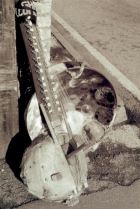
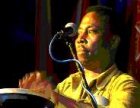
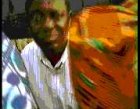
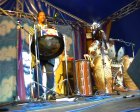
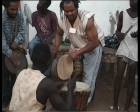

BEAT
Steel pan speaks to kora
On BEAT, the Kora and the Steel Pan meet for the first time to talk to each other. Bravo plays to the kora of Sekou Keita and Jo Jo Yates. The steel pan was born out of poverty, out of struggle and beats a direct link in the chain back to Africa, to the Kora. They speak the same language.
Sonny Akpan - Master Drummer
BEAT is also a fusion of African skin drums and the steel pan as Bravo plays alongside one of Africa's master drummers, Sonny Akpan. Sonny Akpan's style on the Congas is from Eastern Nigeria, a region of around 50 languages or tribal groups. Each area has its own style of rhythms.
Sonny is from Iquaibom, which is well known for its exciting traditional high life music. Bravo has played with him for many years, "He mixes Merengue from Cameroon and Zaire and crosses it over into Nigerian 6/8 beat, it's fused into a modern context, giving him a style all of his own. Eddy Grant would just leave him on stage for ten minutes to solo."
Shango and Warrior Rhythms
Sonny stirs up the devil dance from Nigeria. The Nigerian Jembes knew how to play out deep roots Shango, driving people to catchin' power and falling down. The hold of Shango went across the oceans, with the slaves, from Africa to the Caribbean and Latin America. It was to underpin all rhythms - from Cha-Cha-Cha to Reggae, from Samba to Soca. Bravo first banged out the Jab Jab beat on old petrol drums with his village elders.
The rapid, restructured grooves on BEAT are warrior rhythms, fast moving, driving, a direct link through from Fela to Funk to James Brown in Sex Machine and on to source Rock n' Roll.
A Rare Understanding
From his time in Steel n' Skin, Bravo learnt from working with traditional African drummers and dancers. Sonny points out his awareness of their indigenous beat, patterns and timing: "Other pan players and Caribbean musicians can understand it, but only in part, as it's passed down through Calypso, Soca and Jazz. But Bravo can lock it up with me, he holds it, he knows the language and that's rare. With the Kora again - the dialogue is there. Sekou and Jo Jo use the 6/8 and 5/4 rhythms which underpin the West African beats."
From Waltz to Ol' Kaiso
At the heart of the album lies the steel pan, the music of the ruffian and rebel one moment, catching the sweet dance vibe of ol'Kaiso the next.


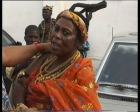

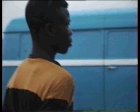
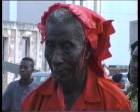
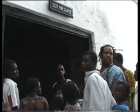
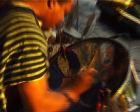
BEAT - about the songs:
1. LITTLE VILLAGE SONG
A relaxed, easy-going stroll in the sun, strictly Hi-Life, Ghana meets Trinidad, the Nyaniba Kora sounds like a steel guitar, blended with the South American Tongue drum.
2. SALLOO THAI (ACROSS THE BORDER)
The pan plays the melody and the Kora comes on in over it, like the sun catching the ocean on a summer's day. Similar to the piano and the harp, the Kora can always sound distinct above the pan that has a lower register.
3. GOIN' GOIN' GONE
Part of Bravo's background is playing classical western music on the pan. This has the echoes of an old European waltz, suggesting a parlour piano with the heavy Nigerian Brekete drum overlay.
4. DANCING WITH FRIENDS
Kaiso enjoying a good old-fashioned dance in a little cosy bar, down some back street. It's a celebration of feeling close to people, that magic moment in the party that you'd love to go on and on.
5. VOODOO GROOVE
Sonny's special blend of conga playing, with a nice Hi-life lick, hear the Merengue feel to it and the big Ghanaian bass drum bringing in an old Shango vibe.
6. AA MONTA (REACHING OUT)
The Pan and Kora spark off one another and let fly in a cutting edge dialogue.
7. STORM
A raw discord as the clouds come over, whipping up a challenge.
8. BEAT THEM
A Calypso rhythm fused with traditional Iquaibom Nigerian high life. Treat Ya Fut!
9. JOURNEY
In memory of the many journeys taken by the African peoples - on slave trips, leaving the Caribbean to a place of not belonging. In memory of Bravo's father - Robert Bravo.
10. DREAMING
How we rise above our suffering, go beyond our present state, unafraid to dream.
11. CORRUPTION
A lamentation underpinned by the Nyabinghi Rasta chant. Rasta's play the congas left to right, whereas most other conga playing is right to left. The first time Bravo played it, "I couldn't do it, then an old Jamaican spar told me the secret - Man play drum left ta right and ya'll get de feel."
12. WAILING STEEL
The steel pan man created this instrument against all the odds of his people's poverty and shame. He made an old oil can, despite all the discrimination, a tribute to the black race.
Pan men were held in a negative light, as rebels and trouble-makers, refusing to conform to the white European way of doing things. The steel pan has become, though, one of the greatest achievements of the Caribbean.
It's a creation, unique to the twentieth century, originating in Trinidad, born of a struggling people, giving expression to the pain and joy of survival and endurance.
The Musicians on BEAT:
Fimber Bravo - Steel Pan, Bongo, Jun Jun, Djembe, Tongue Drum, Talking Drum and Vocals
Sonny Akpan - Congas, Bongo, Brekete, Calabash, Talking Drum and Vocals
Sekou Keita - Kora
Jo-Jo Yates - Kora (Nyaniba)